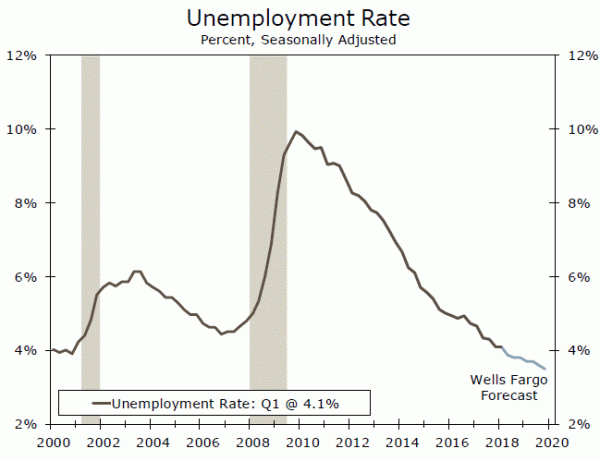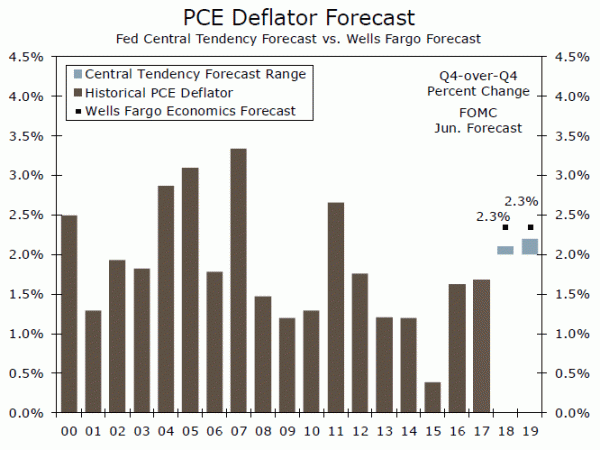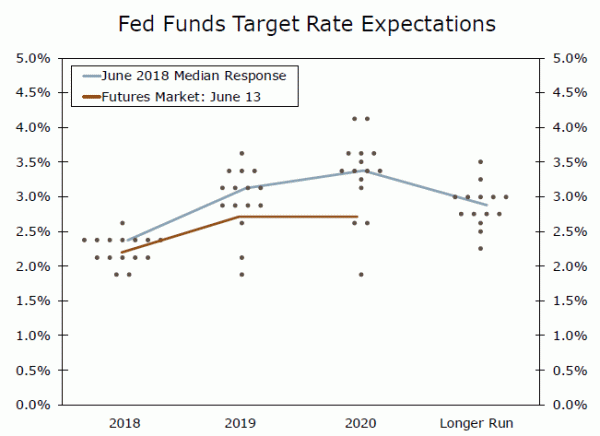The Fed raised the funds rate in June and added a fourth rate hike this year while upgrading its outlook for GDP and inflation. The Fed dropped guidance that the funds rate will stay below the long term rate for a while.
Policy Driver: Lower Unemployment Rates
For the FOMC, the decline in the unemployment rate below 4 percent (top graph) signals future upward pressure on inflation, therefore supporting continued fed funds rate increases. But how many?
In the current economic expansion, the decline in the unemployment rate has not been matched by an anticipated increase in measured inflation. The simple unemployment-inflation link has been broken by changes in demographics (declining labor force participation rates) and the globalization of the labor market. In addition, inflation, and thereby inflation expectations, have lowered the incentive of workers to seek higher wages to offset inflation, while having limited the ability of firms to offset higher wages by passing them on via higher consumer prices.
For decision makers, the decline in the unemployment rate has not been an effective tool for forecasting inflation. Moreover, the FOMC itself has regularly lowered its measure of the natural unemployment rate, effectively following the labor market decline in the unemployment rate while waiting for inflation to accelerate.
Inflation Overshoot: Tolerable – Yet Risky
As illustrated in the middle graph, the FOMC’s benchmark inflation rate is expected to exceed its 2 percent long-term inflation target by 2019. Our estimate is that the PCE deflator will be above target starting in the second half of this year.
For the FOMC, they are comfortable with the overshoot and argue that their inflation target is symmetric around 2 percent. But will the economy and markets tolerate that? The persistence of above 2 percent inflation will have to be priced into short-term debt instruments even if the market and FOMC believe that the long-run target for inflation remains at 2 percent. For now, the spread between the benchmark 30-year and 10-year Treasury yields reinforce the belief that markets are okay with FOMC actions. However, there is a risk that the longer the FOMC tolerates above-target inflation, the more likely that markets will believe that the FOMC will have the courage to rein in inflation sometime in the future.
Dot-Plot: Realistic Given the Economy?
For the FOMC, the way ahead for the funds rate is clear, with steady rate increases in 2018, 2019 and 2020. We are skeptical. Our outlook is that the FOMC has given us a very linear projection in the fed funds rate through 2020, while also pursuing shrinkage in its balance sheet. Given the recent increases in auto and credit card delinquency rates, there is evidence of growing financial strains on mid-to-lower-credit households that may weaken overall economic growth into 2020. Linear projections in a cyclical economy do not raise our level of confidence. Source: FRB, U.S. Department of Labor, U.















